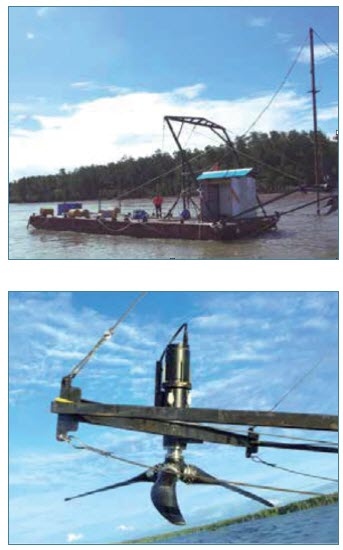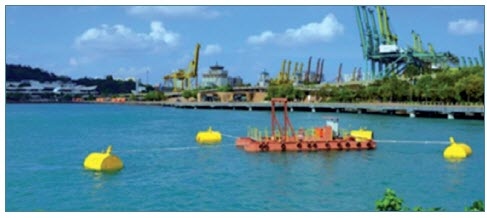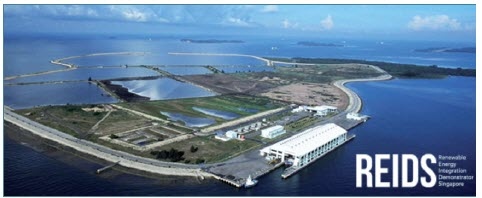SINGAPORE
TECHNOLOGY DEMONSTRATION
OPEN SEA TEST SITES
Sentosa – ERI@N Tidal Site
The Sentosa Tidal Test Site is a joint collaboration between Sentosa Development Corporation (SDC) and ERI@N, funded by the Ministry of Trade and Industry’s Core Innovation Fund. This project aims to showcase tidal energy extraction as a feasible and sustainable energy generating technology in Singapore and to provide opportunities to develop local technologies to harness the energy available in the narrow channel between Singapore and Sentosa. In November 2013, ERI@N and SDC officially launched the Sentosa Tidal Test Site (NTU, 2013). Recent developments on the test site include the deployments of tidal turbines supported from the floating barges. Also, novel concepts such as anti-biofouling coatings are being evaluated for better field performance. The power developed is used for electric lighting on the boardwalk.

Floating hinged turbine support frame to house tidal turbine devices(Left), Scaled (1:3) tidal turbine in tow tank (Middle)
and successful deployment of the turbine at Sentosa Test site. (Right)
|
ERI@N Tidal Turbine System This project is one of the pioneering tidal turbine deployments in Southeast Asia and may act as a model for smaller scale energy developments in coastal areas throughout Southeast Asia. This project also shows that successful deployment of ocean renewable energy technologies could be possible through regional and international collaboration with the involvement of academic and industrial partnership. The island micro grid is currently using diesel generators to power its operations. A hybrid renewable energy solution, including tidal energy, will improve the operations of the island in terms of having a cleaner and relatively cheaper energy source. The continued monitoring of the deployed solution and of the project’s impact to GPFT and PT BUMWI’s locality will be a key in scaling up such initiatives. The present test bedding effort shows that a similar approach towards adoption of ocean renewable energy is achievable to empower remote islands in the Southeast Asian region. Taking this inspiration, there is now some traction in developing similar projects in locations such as those in Indonesia, Vietnam, Malaysia, Myanmar, and the Philippines. |
|
OPERATIONAL PROJECTS
| Barge based floating tidal system In the interest of promoting sustainable energy solutions to achieve energy security with reduced carbon footprint from tropical regions, the Energy Research Institute at Nanyang Technological University (ERI@N) works with international partners in developing and test bedding tidal in-stream energy systems for island conditions with micro grids architecture. Recent developments include the deployment of scaled tidal turbines supported from the floating barges. Image below shows the barge based tidal system which is further scalable to any site flow conditions to operate in any south East Asian country. The project was developed through a collaborative effort of Energy Research Institute at Nanyang Technological University (ERI@N) together with Schottel Hydro, OceanPixel and Lita Ocean Pte Ltd. |
Barge based floating tidal system |
PLANNED DEPLOYMENTS
Renewable Energy Integration Demonstrator-Singapore (REIDS)
REIDS aims to power Pulau Semakau, an island south of mainland Singapore, which serves as a landfill, purely through renewables, including ocean energy. First of its kind in the region, the hybrid micro grid will facilitate the development and commercialization of energy technologies suited for tropical conditions that will help address the growing demand for renewable energy technologies in Asia. REIDS will integrate multiple renewables and novel technologies such as power-to-gas technologies and smart hybrid grids, and enable the development of solutions suited for small islands, isolated villages, and emergency power supplies.
REIDS Onshore: The REIDS onshore project aims to solve engineering, economic, environmental and societal energy transition challenges for off grid communities. It customizes grid science towards remote islandic needs and integrates various renewables. Technologies deployed at the test bed include solar photovoltaic, wind, tidal, energy storage, bioenergy, innovative water desalination, hydrogen production, etc. Presently, work is in progress to make the island energy self-sufficient with its renewable sources.
REIDS Offshore: The offshore renewable energy integration and demonstration (Offshore REIDS) project, also termed as Tropical Marine Energy Centre (TMEC), has been initiated by ERI@N and financially funded by the ClassNK firm (a Japanese classification society) and seeks to pave the way for establishing the world’s first scaled marine renewable energy testing facility for tropical needs. In March 2015, the feasibility study for the test sites was officially launched and is expected to be completed by December 2017. Presently, an environmental impact assessment (EIA) for the test sites has been carried out to understand the impact of ocean energy system deployment on marine life and environment. |
Renewable Energy Integration Demonstrator Singapore |
The outcome of this project will be extended towards Singapore’s guidelines and standards development to support local supply chain’s marine energy resource mapping guidelines of new regions, such as our neighbouring region of Southeast Asia and other tropical islands and remote coastal regions. Overall, the present project aims to develop technologies and deployment methodology for meeting energy needs towards the remote island region.






